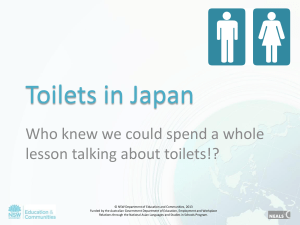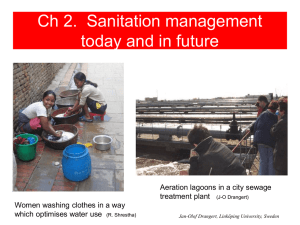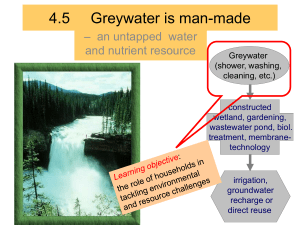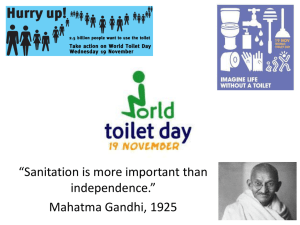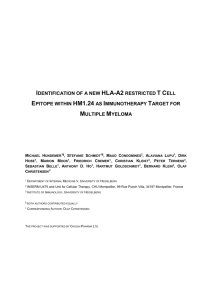School toilets - Sustainable Sanitation
advertisement
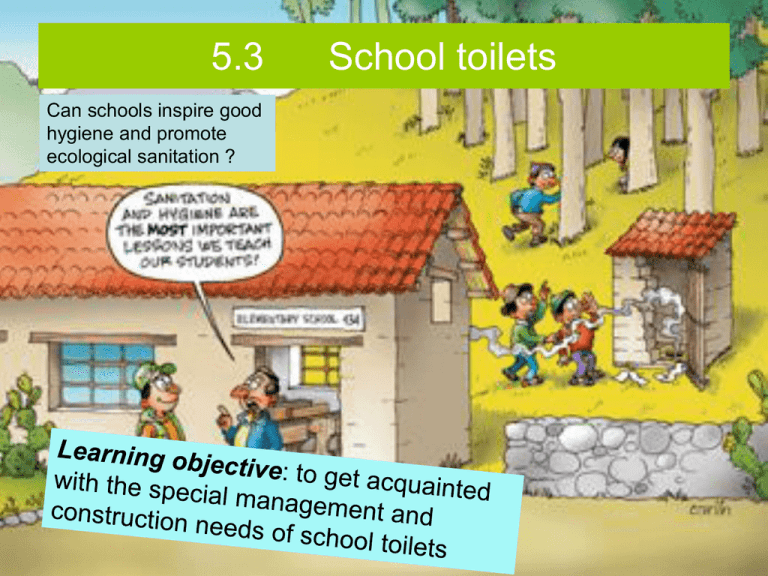
5.3 Can schools inspire good hygiene and promote ecological sanitation ? School toilets J-O Drangert, Linkoping university, Sweden Variations in the quality of school toilets Hygienic conditions for pupils and school staff Incinerator for sanitary pads Water ”tap” for washing hands using 0.1 litre per hand wash Courtesy of Maria Ines Matiz, Colombia and Subburaman, Scope, India Siting: indoors or in the yard ? Class Class rooms rooms toilets Today TOILETS OUTSIDE Impact on individual Impact on environment Tomorrow INSIDE TOILETS - No hand washing - Hand washing - Soiled shoes or feet - Clean shoes - May choose not to use toilet (due to cold, dirt, flies etc.) - Attractive for girls - Groundwater pollution - No groundwater contamination - Excreta stay in the ground - Productive use possible - Loss of nutrients - Some smell when emptying J-O Drangert, Linkoping university, Sweden toilets School toilet planning - FUNCTIONS Criterion 1: waiting time Criterion 2: Access to water Criterion 3: No disease spread Adequate number of toilets Use allowed all times of the day Introduce female urinals Enough time to eat Complement existing source Pupils bring along water Hand washing before eating Clean floors Monitoring Criterion X: cleanliness J-O Drangert, Linkoping university, Sweden Construction & cost reduction Girls’ school urinals School toilet in historic village of Hougou Village, China Courtesy of Peter Morgan, Zimbawe School toilet design Bird's eye view: Section J-O Drangert, Linkoping university, Sweden Smell of urine in the toilet room Urine pipes and tanks in inspection chamber under the toilet floor cubicle cubicle Inspection chamber Urine tank J-O Drangert, Linkoping university, Sweden Girls´ school toilet Girls´ urinals in a Musiri school, India with a water storage for washing Girls´ school toilet, Indonesia with natural light and ventilation Courtesy of Scope, India and Naning Adiwoso, Indonesia Where does urine and faecal matter end up? J-O Drangert, Linkoping university, Sweden School gardens and production of food Soil from organic compost, Colombia Plant trials in Zimbabwe with only water (left) and also urine (right) given to canola, spinach and maize Urine fertilised plants in Brazil Courtesy Ana Claudia Braga Courtesy of Peter Morgan, Zimbabwe and Maria Ines Matiz, Colombia From garden via kitchen to the pupils’ plates Beans for the meal School toilet Preparation of school meal Courtesy of Kitchengarden Foundation, Australia Example 1: Urban and rural schools in Kenya Girls´ observed handwash Boys´ observed handwash Girls reported toilet use Boys observed toilet use Clean toilets Water for handwash in toilet School has all three facilities Water for washing hands in toilet Number of pupils per tap O&M carried out Perceived toilet cleanliness Perceived privacy in toilet Girls´ school absences Source: V. Njuguna et al. 2009 No of children per tap Example 2: Rural schools in Colombia Sanitary services in rural schools in Anapoima Name El Cabral El Copial El Consuelo El Higuerón Las Mercedes Santa Lucía San Antonio La Guasima Lutaima La Palmichera El Rosario Santa Ana Andalucía Calichana La Esmeralda La Esperanza Golconda Panamá Patio Bonito Nº students 15 18 48 toilets 4 6 4 wash bowls yes yes yes TABLE #9 soap yes no no towel yes no no 48 15 160 18 22 18 5 4 9 3 2 4 yes yes yes yes yes yes yes yes no no yes yes no yes no no yes yes 34 18 2 2 yes yes no no no no 19 1 yes no no 28 39 150 2 2 5 no yes yes no no no no no no Courtesy of Maria Ines Matiz, El Bosque University, Colombia Assessing conditions in schools in Colombia TABLE#16 Name Entry Inside Exit El Bejucal Guacamaya Guacana Nueva Charcolargo El Naranjal Naranjalito Pantanos Escuela Salcedo Nueva rural La Vega Cachimbulo La Orqueta Palmar Esc. Nva. rural Meseta Paloquemado San Antonio Daily aqueduct service Aqueduct Service, every 3 days Aqueduct service every 2 days. No service. Depend on rain fall and water truck. Filters or boil Sewer and septic hole Nothing Open field Courtesy of Maria Ines Matiz, El Bosque University, Colombia Example 3: Rural and urban schools in the Ukraine J-O Drangert, Linkoping university, Sweden Management options Item Conditions (OK, fair, needs) Measure to take (repair, replace) Who is responsible Cost estimate Toilet room: Toilet floor Pedestal or pan janitor Water seal Ventilation Urine pipes janitor Water seal H/master Drainage pipe Soak-away Door and hinges H/master Plaster on walls Paint of urinal J-O Drangert, Linkoping university, Sweden Management of school sanitation facilities Courtesy of Oliver Ives, ‘Amanz’ abantu Services Ltd, South Africa Population increase as a challenge Number of additional teachers and classrooms required to provide primary education for all new-born Year Population Increase 000´ in Total Newborn New classVII rooms Number of classes (000´) in Standard I II III IV V VI 0 23.0 690 1.150 - - - - - - - 1 23.7 710 1.185 1 - - - - - - 1,000 2 24.4 732 1.220 2 1 - - - - - 3,000 3 25.1 754 1.257 3.1 2 1 - - - - 6,100 4 25.8 774 1.290 4.1 3.1 2 1 - - - 10.200 5 26.6 797 1.330 5.2 4.1 3.1 2 1 - - 15,400 6 27.4 821 1.369 6.3 5.2 4.1 3.1 2 1 - 21,700 7 28.2 846 1.410 7.3 6.3 5.2 4.1 3.1 2 1 29,000 J-O Drangert, Linkoping university, Sweden - Awareness raising From Ajzen (2002)
